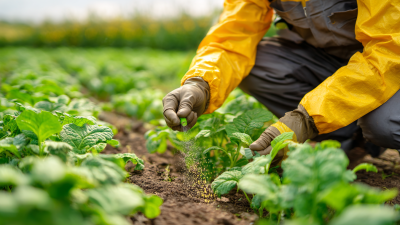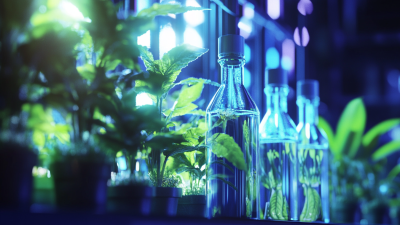 0551-68500918
0551-68500918 





The herbicide manufacturing industry is really going through some big changes lately. Thanks to new tech, shifting regulations, and evolving farming practices, things are moving fast. Companies are always trying to innovate and come up with better products, so it’s pretty important to stay on top of these trends and challenges if you want to succeed. For example, Innovation Meiland (Hefei) Co., LTD. based out of Hefei, China, is actually leading the charge in this space. They’re heavily focused on R&D — working on new pesticide formulas, products, and processes. By putting a real emphasis on innovative solutions, Meiland Stock is positioning itself to meet the ever-changing needs of the herbicide industry. They’re really honing in on sustainable methods and smarter weed control strategies. In this blog, we’ll take a look at the latest trends shaking up the herbicide world and chat about some of the hurdles companies like Meiland Stock are facing as they compete in this fast-paced, competitive market.

Right now, the herbicide industry is really going through some big changes that are reshaping the whole scene. One of the biggest trends? Moving towards more sustainable and eco-friendly herbicide options. You know how regulations are getting tougher and more people are aware of how harmful traditional herbicides can be? Well, companies are pouring a lot of effort into research and innovation—trying to come up with bio-based, less toxic solutions. These new developments not only help them meet tougher rules, but they also appeal to an increasingly eco-conscious customer base.

On top of that, advancements in tech—like precision agriculture—is totally changing the game. With data analytics, artificial intelligence, and dronesbeing used more and more, Herbicide Application is becoming super targeted. This means farmers can use just the right amount, cutting waste and minimizing environmental impact. Not only does this boost crop yields, but it also plays a part in making the industry moresustainable overall. As these trends keep growing and evolving, the herbicide sector is really stepping into a new role—striking a balance between productivity and caring for the environment.
Right now, the herbicide plant industry is dealing with a bunch of challenges that are really shaping what’s ahead. One big thing on everyone's mind is moving towards more sustainable and eco-friendly practices. With the bio pesticide market expected to grow quite a bit, it’s clear that there's a rising demand for more natural farming methods and organic foods. Basically, this means a shift away from traditional Chemical Herbicides to greener, more eco-friendly options. It’s forcing companies to get creative — whether in developing new products or even rethinking how they market them.
Looking ahead to 2025, everyone’s talking about this ‘just-in-time’ market for herbicides, which means suppliers need to be super quick and responsive to what retailers and growers need. That puts a big emphasis on better logistics and supply chain management — collaborations between manufacturers and retailers are more important than ever. However, making the supply chain more efficient isn’t without its hurdles — it’s tricky to keep products effective while also sticking to sustainable practices in protecting crops.
On top of that, tech is really starting to shake things up. Advances in AI and IoT are opening up new doors for boosting productivity and sustainability, not just in herbicide application but across farming in general. It’s an exciting time that’s setting the stage for some serious transformation in how the herbicide industry operates.
Hey, have you noticed how the herbicide industry is really starting to focus more on sustainability and caring for the environment? I was reading a recent report from the World Agricultural Outlook Board, and it says the worldwide herbicide market hit around $25 billion in 2022. And get this — it's expected to keep growing, thanks to the increasing need for effective weed control solutions. But, of course, with this growth comes the responsibility to be more eco-friendly. You know, things like pesticide runoff and soil health are big issues, especially since studies show that nearly 80% of herbicides can end up in water bodies, which definitely puts aquatic life at risk.
To tackle these problems, lots of companies are stepping up and adopting smarter, greener production methods. For example, using precision agriculture techniques and integrated pest management really helps cut down herbicide use—sometimes by as much as 30%. That’s a pretty significant drop, which is great for the environment. Plus, there’s a real push now for creating biodegradable herbicides, and according to MarketsandMarkets, this segment might grow at about 10% annually over the next five years. It’s cool to see how the industry is shifting towards more sustainable practices that not only work well but also care for our planet. All this effort isn’t just good for the environment — it also lines up with what consumers are now expecting: greener, more responsible agriculture.
As the herbicide industry keeps evolving, it's pretty clear that technological innovations are really shaping where things are headed. You know, things like new formulations, more precise application methods, and using data to guide decisions are really changing the game—both in how herbicides are made and how they're used. By tapping into tech like AI and machine learning, companies now have the ability to develop more efficient, environmentally friendly herbicides that can target specific weeds without messing up nearby crops. That’s a big win, right? Not only does it help boost yields, but it also lines up with the growing push for sustainable farming practices.
**Pro tip:** If you’re involved in herbicide development, try integrating digital tools into your process. Using software for data analysis can really help you spot market trends and make your formulations better, which means your products will work more effectively.
On another note, have you noticed the rise of biopesticides? They're becoming super popular as a natural alternative to traditional herbicides. Consumers and regulators alike are calling for greener solutions, and the biotech advancements are making it possible to target specific pests or diseases without the harsh effects associated with conventional methods.
**Another tip:** Keep yourself in the know about the latest in biopesticides. Joining collaborative research with universities or industry peers can give you fresh insights and spark some innovation in your own products. It's all about staying ahead of the curve, you know?
The herbicide industry is currently dealing with some pretty complex market issues, with demand and supply factors playing off each other in interesting ways. If you look at the forecasts, the global diethanolamine market is expected to jump from around $930 million in 2025 to about $1.3 billion by 2032. That’s good news for the herbicide segment, which really depends on these chemicals because they’re so vital for crop protection and boosting agricultural productivity. Companies like Meiland Stock are really stepping up, working hard on new pesticide formulas that not only match these changing market demands but also aim to be more effective, safe, and environmentally friendly.

Over in the U.S., the pyridine market has actually stayed pretty steady, thanks to a good balance between supply and demand. That kind of stability is super important for herbicide manufacturing since it means raw materials are readily available, helping keep supply chains running smoothly. On the flip side, China’s agrochemical scene has been quite tumultuous lately — with prices swinging and the whole pesticide supply chain getting reorganized. That’s forcing local crop protection companies to get creative and adapt quickly. As the industry navigates all these shifts, there’s a big focus on developing herbicides that not only work well but are also greener and safer, because staying competitive on the global stage really depends on that.
In a world increasingly aware of the impact of chemicals on our health and environment, opting for plant-based deodorizers is a natural choice for a fresher, safer home. Harnessing nature’s power, these eco-friendly solutions utilize a variety of plant extracts that effectively neutralize unwanted odors. Whether in kitchens, bathrooms, or even outdoor spaces like landfills and breeding farms, these deodorizers offer a quick and efficient way to combat foul smells without introducing harmful chemicals.
Using these products is as simple as it gets. The active ingredient blend is designed for convenience; just spray directly onto the area, or dilute it with water at a ratio of 1:5 to 1:10 for a more gentle application. Perfect for various settings, from busy restaurants to residential buildings, plant-based deodorizers ensure a fresh atmosphere while being safe for both humans and pets. By choosing these natural alternatives, not only can you eliminate unpleasant odors, but you also contribute to a healthier planet.
: The herbicide plant sector is facing challenges related to the transition towards sustainable and eco-friendly practices, the need for enhanced supply chain capabilities to respond to market demands, and the need for innovation in product development and marketing strategies.
The industry is shifting from traditional chemical herbicides to biodegradable and eco-friendly alternatives, using advanced production techniques and precision agriculture methods to reduce environmental impacts.
The global herbicide market was valued at approximately $25 billion in 2022 and is expected to grow further, driven by rising demand for effective weed management solutions.
Technological innovations, including AI and machine learning, are transforming herbicide development by allowing for more efficient, targeted applications that minimize environmental impact while increasing yield.
Nearly 80% of herbicides can end up in water bodies, which poses significant threats to aquatic ecosystems due to pesticide runoff and soil degradation.
Biopesticides, which are natural alternatives to synthetic herbicides, are gaining popularity as consumers and regulators seek greener solutions, particularly due to advancements in biotechnology.
Precision agriculture techniques can reduce herbicide application rates by up to 30%, leading to lower environmental burdens and improved sustainability in agricultural practices.
Collaboration between manufacturers and retailers is crucial for enhancing supply chain efficiency and creating responsive market strategies that meet the needs of growers and consumers.
The biodegradable herbicide segment is projected to grow at a CAGR of 10% over the next five years, indicating a significant shift towards sustainable agricultural practices.
Integrating digital tools for data analysis can help companies identify market trends and improve formulation efficiency, leading to better product performance and competitiveness in the herbicide market.
The herbicide plant industry has been going through some pretty big changes lately, mainly thanks to new trends and tech innovations. Companies like Meiland Stock are really putting their efforts into researching and developing fresh pesticides and formulations. Because of that, we're seeing a shift toward more eco-friendly and sustainable production methods—which is pretty exciting. Of course, it's not all smooth sailing; there are some big challenges on the horizon, like tough regulations and the ongoing race to make herbicides more effective.
Market forces such as supply and demand are still huge factors influencing the industry. As folks become more aware of environmental issues, everyone involved has to juggle these complexities—trying to satisfy consumers while staying within regulatory boundaries. Looking ahead, it’s clear that embracing the latest technologies will be key in shaping how herbicide plants operate, helping them stay sustainable and profitable in an increasingly competitive landscape.







